Abstract
Expression of oncogenic Ras in primary human cells activates p53, thereby protecting cells from transformation. We show that in Ras-expressing IMR-90 cells, p53 is phosphorylated at Ser33 and Ser46 by the p38 mitogen-activated protein kinase (MAPK). Activity of p38 MAPK is regulated by the p53-inducible phosphatase PPM1D, creating a potential feedback loop. Expression of oncogenic Ras suppresses PPM1D mRNA induction, leaving p53 phosphorylated at Ser33 and Ser46 and in an active state. Retrovirus-mediated overexpression of PPM1D reduced p53 phosphorylation at these sites, abrogated Ras-induced apoptosis and partially rescued cells from cell-cycle arrest. Inactivation of p38 MAPK (the product of Mapk14) in vivo by gene targeting or by PPM1D overexpression expedited tumor formation after injection of mouse embryo fibroblasts (MEFs) expressing E1A+Ras into nude mice. The gene encoding PPM1D (PPM1D, at 17q22/q23) is amplified in human breast-tumor cell lines and in approximately 11% of primary breast tumors, most of which harbor wildtype p53. These findings suggest that inactivation of the p38 MAPK through PPM1D overexpression resulting from PPM1D amplification contributes to the development of human cancers by suppressing p53 activation.
This is a preview of subscription content, access via your institution
Access options
Subscribe to this journal
Receive 12 print issues and online access
$209.00 per year
only $17.42 per issue
Buy this article
- Purchase on Springer Link
- Instant access to full article PDF
Prices may be subject to local taxes which are calculated during checkout




Similar content being viewed by others
References
Appella, E. & Anderson, C.W. Post-translational modifications and activation of p53 by genotoxic stresses. Eur. J. Biochem. 268, 2764–2772 (2001).
Vogelstein, B., Lane, D. & Levine, A.J. Surfing the p53 network. Nature 408, 307–310 (2000).
Lin, A.W. et al. Premature senescence involving p53 and p16 is activated in response to constitutive MEK/MAPK mitogenic signaling. Genes Dev. 12, 3008–3019 (1998).
Zhu, J., Woods, D., McMahon, M. & Bishop, J.M. Senescence of human fibroblasts induced by oncogenic Raf. Genes Dev. 12, 2997–3007 (1998).
Ferbeyre, G. et al. PML is induced by oncogenic ras and promotes premature senescence. Genes Dev. 14, 2015–2027 (2000).
Palmero, I., Pantoja, C. & Serrano, M. p19ARF links the tumour suppressor p53 to Ras. Nature 395, 125–126 (1998).
Wei, W., Hemmer, R.M. & Sedivy, J.M. Role of p14ARF in replicative and induced senescence of human fibroblasts. Mol. Cell. Biol. 21, 6748–6757 (2001).
Bulavin, D.V. et al. Phosphorylation of human p53 by p38 kinase coordinates N-terminal phosphorylation and apoptosis in response to UV radiation. EMBO J. 18, 6845–6854 (1999).
Takekawa, M. et al. p53-inducible Wip1 phosphatase mediates a negative feedback regulation of p38 MAPK-p53 signaling in response to UV radiation. EMBO J. 19, 6517–6526 (2000).
Webley, K. et al. Posttranslational modifications of p53 in replicative senescence overlapping but distinct from those induced by DNA damage. Mol. Cell. Biol. 20, 2803–2808 (2000).
Fiscella, M. et al. Wip1, a novel human protein phosphatase that is induced in response to ionizing radiation in a p53-dependent manner. Proc. Natl Acad. Sci. USA 94, 6048–6053 (1997).
Bulavin, D.V. et al. Initiation of a G2/M checkpoint after ultraviolet radiation requires p38 kinase. Nature 411, 102–107 (2001).
Jimenez, G.S. et al. A transactivation-deficient mouse model provides insights into Trp53 regulation and function. Nature Genet. 26, 37–43 (2000).
O'Connor, P.M. et al. Characterization of the p53 tumor suppressor pathway in cell lines of the National Cancer Institute anticancer drug screen and correlations with the growth-inhibitory potency of 123 anticancer agents. Cancer Res. 57, 4285–4300 (1997).
Tirkkonen, M. et al. Molecular cytogenetics of primary breast cancer by CGH. Genes Chromosom. Cancer 21, 177–184 (1998).
Hofmann, T.G. et al. Regulation of p53 activity by its interaction with homeodomain-interacting protein kinase-2. Nature Cell Biol. 4, 1–10 (2002).
D'Orazi, G. et al. Homeodomain-interacting protein kinase-2 phosphorylates p53 at Ser 46 and mediates apoptosis. Nature Cell Biol. 4, 11–19 (2002).
Kononen, J. et al. Tissue microarrays for high-throughput molecular profiling of tumor specimens. Nature Med. 4, 844–847 (1998).
Woods, D.B. & Vousden, K.H. Regulation of p53 function. Exp. Cell Res. 264, 56–66 (2001).
Esteller, M. et al. Hypermethylation-associated inactivation of p14ARF is independent of p16INK4a methylation and p53 mutational status. Cancer Res. 60, 129–133 (2000).
Ho, G.H. et al. Genetic alterations of the p14ARF-hdm2-p53 regulatory pathway in breast carcinoma. Breast Cancer Res. Treat. 65, 225–232 (2001).
Oliner, J.D., Kinzler, K.W., Meltzer, P.S., George, D.L. & Vogelstein, B. Amplification of a gene encoding a p53-associated protein in human sarcomas. Nature 358, 80–83 (1992).
Moll, U.M., LaQuaglia, M., Benard, J. & Riou, G. Wild-type p53 protein undergoes cytoplasmic sequestration in undifferentiated neuroblastomas but not in differentiated tumors. Proc. Natl Acad. Sci. USA 92, 4407–4411 (1995).
Raman, V. et al. Compromised HOXA5 function can limit p53 expression in human breast. Nature 405, 974–978 (2000).
Choi, J. et al. Mice deficient for the wild-type p53-induced phosphatase gene (Wip1) exhibit defects in reproductive organs, immune function, and cell cycle control. Mol. Cell Biol. 22, 1094–1105 (2002).
Bièche, I. & Lidereau, R. Genetic alterations in breast cancer. Genes Chromosom. Cancer 14, 227–251 (1995).
Li, J. et al. Oncogenic properties of PPM1D located within a breast cancer amplification epicenter at 17q23. Nature Genet. 31 (2002); advanced online publication, 20 May 2002 (DOI: 10.1038/ng888).
Bulavin, D.V., Tararova, N.D., Aksenov, N.D., Pospelov, V.A. & Pospelova, T.V. Deregulation of p53/p21Cip1/Waf1 pathway contributes to polyploidy and apoptosis of E1A+cHa-ras transformed cells after γ-irradiation. Oncogene 18, 5611–5619 (1999).
Oster, S.K. et al. Myc is an essential negative regulator of platelet-derived growth factor. Mol. Cell. Biol. 20, 6768–6778 (2000).
Bargmann, C.I., Hung, M.C. & Weinberg, R.A. Multiple independent activations of the neu oncogene by a point mutation altering the transmembrane domain of p185. Cell 45, 649–657 (1986).
Saito, S. et al. ATM mediates phosphorylation at multiple p53 sites, including Ser46, in response to ionizing radiation. J. Biol. Chem. 277, 12491–12494 (2002).
Acknowledgements
We are grateful to J. Hildesheim for help with real-time PCR, J. Clark for help with DNA sequencing and T. Dennis for help with FISH analysis. This study was supported in part by a US Army Breast Cancer Idea Award (to C.W.A.) at the Brookhaven National Laboratory under contract with the US Department of Energy.
Author information
Authors and Affiliations
Corresponding author
Ethics declarations
Competing interests
The authors declare no competing financial interests.
Supplementary information
Rights and permissions
About this article
Cite this article
Bulavin, D., Demidov, O., Saito, S. et al. Amplification of PPM1D in human tumors abrogates p53 tumor-suppressor activity. Nat Genet 31, 210–215 (2002). https://doi.org/10.1038/ng894
Received:
Accepted:
Published:
Issue Date:
DOI: https://doi.org/10.1038/ng894
This article is cited by
-
Prevalence, causes and impact of TP53-loss phenocopying events in human tumors
BMC Biology (2023)
-
Clonal haematopoiesis - a novel entity that modifies pathological processes in elderly
Cell Death Discovery (2023)
-
Ppm1d truncating mutations promote the development of genotoxic stress-induced AML
Leukemia (2023)
-
Clonal Hematopoiesis of Indeterminate Potential: Current Understanding and Future Directions
Current Oncology Reports (2023)
-
Overexpression of NCAPG in ovarian cancer is associated with ovarian cancer proliferation and apoptosis via p38 MAPK signaling pathway
Journal of Ovarian Research (2022)



